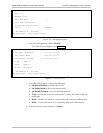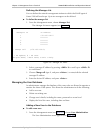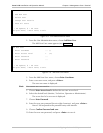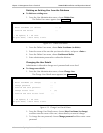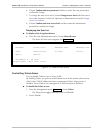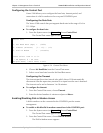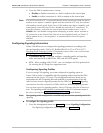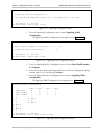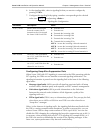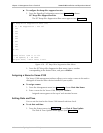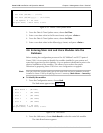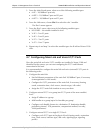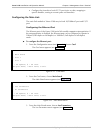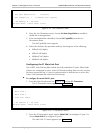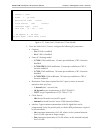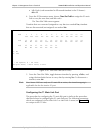
Vmux-2100 Installation and Operation Manual Chapter 4 Management from a Terminal
Configuring the Vmux-2100 System 4-15
6. In the signaling table, select a signaling bit that you want to configure by
pressing <Tab>.
7. Configure the signaling bit by typing a number corresponding to the desired
value (see Table 4-1), and pressing <Enter>.
Table 4-1. Signaling Bits Configuration
Parameter Description Value
A, B, C, D Bit Selects which incoming bit
(from the remote side) to
transmit on the A bit toward
the Vmux-2100’s local PBX.
0 – Transmits zero
1 – Transmits one
A – Transmits the incoming A bit
B – Transmits the incoming B bit
C – Transmits the incoming C bit
D – Transmits the incoming D bit
NOT A – Inverts the incoming A bit and transmits it
NOT B – Inverts the incoming B bit and transmits it
NOT C – Inverts the incoming C bit and transmits it
NOT D – Inverts the incoming D bit and transmits it
IDLE SIGNAL Selects the code transmitted
on A, B, C, and D bit when the
channel is idle
0 – Transmits zero
1 – Transmits one
OOS SIGNAL Selects the code transmitted
on A, B, C, and D bit when the
channel is out of service
0 – Transmits zero
1 – Transmits one
Configuring Keep-Alive Suppression Rate
When Vmux-2100 with CCS signaling is connected to the PBXs operating with the
SS7 signaling, the PBXs use one timeslot to transmit signaling information. The
signaling information is passed over the signaling link in the form of the following
signal units:
• Message signal units (MSUs) provide all signaling associated with call setup
and tear down, database query and response, and SS7 network management.
• Link status signal units (LSSUs) provide information on the link status
between the network nodes (initiation of link alignment, quality of the
signaling traffic etc).
• Fill-in signal units (FISUs) carry no information payload. They occupy the link,
when there are no MSUs or LSSUs to send. FISUs are also referred to as
“keep-alive” messages.
Often, in the absence of signaling traffic, the signaling links become flooded with
the FISUs, causing communication disruptions. In order to prevent this, you can
enforce Vmux-2100 to drop certain amount of FISUs (up to 90%). You can also
disable the FISU dropping by configuring the keep-alive suppression rate to 0%. It
is necessary, when working with non-SS7 CCS signaling (for example ISDN), or if
the FISUs are used to acknowledge the receipt of the signaling messages. In the
latter case, system performance may become unsatisfactory.



